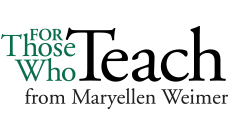I just read a review of the literature on class discussion. It’s from 2013 so there’s more that could be included in the review, but there’s one feature of the literature that I don’t think has changed. Like so many other common teaching and learning terms that get tossed about, we never define what we mean by discussion and yet use it assuming we’re all referencing the same thing.
 A consensually agreed upon definition is probably beyond our
reach—we are academics, known for nitpicking definitions, but failure to define
(as in true with other terms) has serious consequences. This particular review
rounded up 31studies that examined the effect of discussion on student learning,
and in 25 of the studies discussion was not defined. The author writes, “But
because of the failure of most researchers to be clear about the meaning of
discussion, no strong claims about the efficacy of discussion emerge from this
review.” (p. 10)
A consensually agreed upon definition is probably beyond our
reach—we are academics, known for nitpicking definitions, but failure to define
(as in true with other terms) has serious consequences. This particular review
rounded up 31studies that examined the effect of discussion on student learning,
and in 25 of the studies discussion was not defined. The author writes, “But
because of the failure of most researchers to be clear about the meaning of
discussion, no strong claims about the efficacy of discussion emerge from this
review.” (p. 10)
What is it about discussion we’re not defining?
- Length – Is it a discussion if it’s less than five minutes?
- Number of participants – How many voices does it take to become a discussion? We typically consider participation to be a teacher-student exchange. Is it a discussion if four students answer the teacher’s question? Is it a discussion if a student responds to another student’s answer?
- The degree to which it’s topic-focused – Is the designated topic what differentiates a discussion from a conversation? Maybe, but discussions don’t always stay on the topic. They wander, sometime productively, sometimes not so much. What role does topic play in defining discussion?
- The amount of teacher control – What passes as participation usually involves a good deal of teacher control. In order to speak, the student must be recognized by the teacher. The teacher does not need to be recognized before responding to the student. Students do not regulate how much a teacher speaks during an exchange. Can a teacher reciprocate that same amount of control in a discussion? Should teacher control—or a lack of it—be part of how discussions are defined?
- The role of the teacher – Should the teacher make substantial content contributions to a discussion? Can a teacher make too many? Should the teacher function as a discussion facilitator? Should teachers contribute and facilitate?
- The kind commentary – Typically participants in a discussion may ask questions, answer questions, make comments, express opinions, and disagree. Is it a discussion if there’s only questions and answers? Are certain kinds of statements a definable characteristic of discussions?
I usually think of participation and discussion at the ends of a continuum. On the participation end, it’s an isolated teacher-student exchange that typically involves a question and an answer and occurs in the presence of others. Discussion is a topic-focused, lengthier exchange among equals. Like most continuums, what’s on the ends is easy. It’s those spaces in between that are harder to define. In the case of discussion, I think most of us would be hard pressed to say where participation ends and discussion begins and what happens when we vacillate between the two.
This review of the literature identified numerous problems with classroom discussions as they typically occur. Most of us won’t be surprised to learn that in many classroom discussions a lot of students are not participating and teacher commentary makes up for that. In most classroom discussions, the caliber of the comments does not make for rich, stimulating, provocative exchanges. The topics don’t seem all that interesting to students which gives them the reason they need to come to discussions unprepared. Could part of these problems be the result of our failure to clearly define for ourselves and our students what discussion is, why it’s important and how we think it ought to occur?
Most of us use discussion for two good reasons. It’s an instructional method through which students can learn content. They talk about it, explore aspects of it, and come to understand it better. We also use discussion because it develops an important skill—the ability to talk through issues respectfully and productively with others. We need to better understand the role of discussion in both those arenas, and I can’t help but think that needed insights start with clearer definitions for discussion.
Reference: Dudley-Marling, C. (2013). Discussion in postsecondary classrooms: A review of the literature. Sage OPEN, October–December, 1-13. https://doi.org/10.1177/2158244013515688






